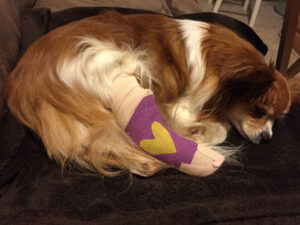
Car accidents, falls, and overly-enthusiastic fetch sessions are just a few of the potential causes of broken bones in dogs. While some minor fractures can be addressed with a splint or cast, more severe breaks may require veterinary surgery or the implantation of metal screws and plates. Fractures of the femur for dogs can be particularly serious since these bones are among the strongest in the body. If your canine companion has sustained a femur fracture, seek veterinary attention and discuss potential treatment options with your veterinary care team.
Risk Factors for Fractures of the Femur for Dogs
While some fractures are unavoidable due to trauma, some underlying conditions and risk factors can increase the likelihood that your companion will sustain a serious fracture. Metabolic disorders like rickets and cancers like osteosarcoma can cause bones to weaken, making them more susceptible to fracture. Smaller, older dogs can also be at greater risk. Small breeds typically have smaller and more fragile bones, while older dogs can have bones that are more brittle.
Common Treatments for Fractures of the Femur for Dogs
Depending on the severity of the fracture, your veterinary care team may recommend any number of treatments. While minor greenstick fractures may be adequately treated using a splint or cast, many fractures of the femur for dogs require more significant intervention. Surgical repairs can involve pins, plates, screws, wires, and other metal implants to stabilize the area and promote healing. The healing process is crucial for fractures, and postoperative care is critical.
Paving the Way to a Smooth Recovery
If your canine companion has undergone surgery to resolve their femur fracture, your veterinary care team will likely provide a comprehensive set of instructions for recovery. This typically includes the following:
- Using an e-collar. These plastic cones can help keep dogs away from their incision sites, limiting the risk of infection or trauma.
- Reducing physical activity and excitement. Your dog will almost certainly try to use their leg before it is fully healed. Try to limit excitement and keep your dog calm, pain-free, and mentally engaged throughout recovery. Your veterinary care team may give specific guidelines for the gradual reintroduction of low-level physical activity.
Trust Maryland Veterinary Surgical Services With Your Companion’s Health
Your companion’s health is important, and the team at MVSS is ready to provide the best care possible for your furry family. We are dedicated to combining comprehensive exams and assessments with informative and honest discussions of your companion’s care. Once we have worked with you to decide on the best course of action for your dog, our professionals will use their surgical expertise to work towards the goal of giving your companion an active and pain-free life. We are proud to serve loyal companions in Catonsville and Baltimore. To learn more about our services, give us a call at 410-788-4088 or visit us online. For more information and tips for pet health, follow us on Facebook and Pinterest.
